2011 President’s Report
Trinity 2011: Success to Launch the Future!
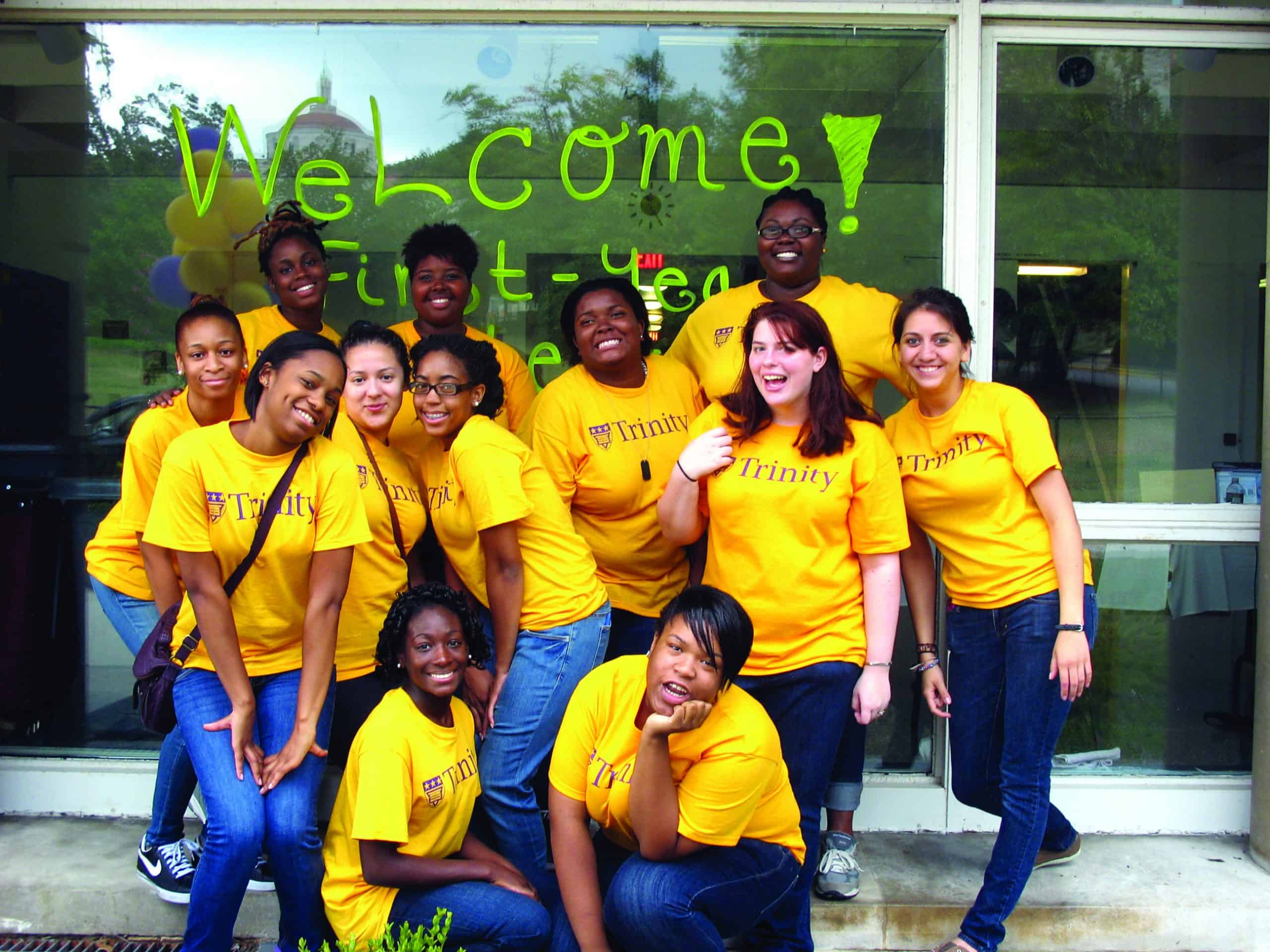
How does Trinity do it?
So many people ask me that question these days. At a time when too many universities are under fire for high costs and disappointing results, Trinity stands out as an example of efficient and effective higher education.
Trinity’s ongoing success story includes these notable facts:
• 2,555 students now enroll in all programs at the university, more than at any other time in our history; Trinity’s student body has grown 93% since 2001.
• Nearly 1,000 young women enroll in the historic women’s college, known as Trinity College of Arts and Sciences, Trinity’s full-time, daytime undergraduate program in the liberal arts. This is the largest women’s college enrollment in Trinity’s history; the women’s college has grown by 135% since 2001.
• 1,600 students applied for admission to the College of Arts and Sciences for Fall 2011, the largest number of applications in Trinity’s history.
• 200+ students are now enrolled in the nursing program, with several hundred more indicating interest in the nursing major.
• $20,150, Trinity’s full-time undergraduate tuition, is the most affordable private college tuition in the region by far, and well below the national average private tuition, underscoring Trinity’s commitment to deliver a high-quality education at a price that students and families can afford.
• 95% of Trinity’s full-time undergraduates receive Trinity grants and scholarships to help offset some of the tuition price, and 100% receive federal financial aid including grants and loans; 70% of Trinity students receive Pell Grants, which are federal grants for students with great need.
• 90% of Trinity’s students are African American, Latina and students of many different races and ethnicities, including a large proportion whose families are recent immigrants from a broad diaspora of nations, particularly from Africa, the Caribbean and Central America.
• 45% of Trinity’s total student body hails from the District of Columbia; Trinity educates more D.C. residents than any private university in the nation.
• 30,000+ people annually visit the Trinity Center for Women and Girls in Sports for health and fitness programs, educational events, Girl Scout activities and a broad range of athletic and recreational competitions and exhibitions, thus raising Trinity’s visibility considerably in the Washington region.
• $35 million is the overall operating budget for Trinity in Fiscal 2012; Trinity is comfortably “in the black” and after many previous decades of financial stress and uncertainty, Trinity is now fiscally stable and building reserves that will ensure a strong foundation for the university’s future.
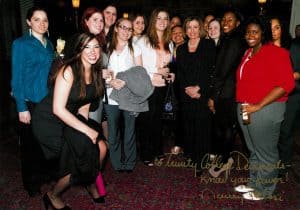
Trinity College Democrats with Nancy D’Alesandro Pelosi ’62
Trinity’s success today is a product of sound planning, smart positioning, and an abundance of hard work on the part of faculty, administrators and students who make sure that Trinity meets its goals every day. Our success is also only possible because of the great loyalty and large support of our alumnae and alumni, family and friends, and we are grateful to each of you for the many ways in which you contribute to Trinity – time, talent, treasure and spreading the good news every day.
Even with so much success, Trinity also faces considerable challenges as the environment for higher education grows more arduous each year. Increased regulation, changing technologies, more urgent workforce needs, larger student expectations and new forms of competition all ensure that Trinity’s leadership and management never sleep!
Trinity’s greatest challenge today is the happy problem of accommodating all of the growth that we have experienced in recent years as we march forward toward the strategic goal of 3,000 students by 2015. We are currently educating 2,555 degree-seeking students in buildings that were designed 50-100 years ago for about 500 traditional-aged resident women.
400 full- and part-time faculty and staff teach and serve this student body, with office and work spaces carved out of old dormitory and convent rooms. There were about 400 students at Trinity when the Science Building opened in 1941 – and at that time it was “state of the art” for undergraduate education, but innovations in technology and scientific learning have changed considerably in the last 70 years, requiring very different laboratory space.
There were 663 students at Trinity in 1963 when classes carried the books from Main Hall to the “new” Sr. Helen Sheehan Library, another building that was “state of the art” when new, but that building now approaches its 50th anniversary at a time when academic libraries are completely different from the designs of the early 1960s.
This President’s Report details our past stewardship of this priceless mission called Trinity even as it presages the beginning of a new era in Trinity’s life: the development of the Trinity Academic Center, the urgent and imperative project to ensure Trinity’s quality, competitiveness, creativity and capacity to sustain this mission for the next 100 years.
As always, this report comes with an immense sense of gratitude to each of you for your generosity and loyalty to Trinity. Thank you on behalf of the students, faculty and staff for whom your support is the best possible affirmation of their work each day.
 President Patricia McGuire
President Patricia McGuire
Enrollment Success: Launching the Future!

The Red Class at the Cap and Gown Sing
Trinity’s Fall 2011 enrollment of 2,555 students is the highest all-time enrollment, a 93% increase over the last ten years. Of this total enrollment, nearly 1,000 young women are in the full-time daytime women’s college, still known as Trinity College, our College of Arts and Sciences (CAS). Few women’s colleges are growing today, and for Trinity College to grow by 135% in a decade is a remarkable achievement. This year’s women’s college enrollment is an all-time high for Trinity.
The chart below shows Trinity’s overall enrollment growth across the last ten years, with segments of the columns showing each academic unit: the College of Arts and Sciences (CAS = yellow), the School of Education (EDU = blue), the School of Professional Studies (SPS = red) and the School of Nursing and Health Professions (NHP = green).
What strategies made it possible for Trinity’s enrollment to grow robustly in the last ten years? While many factors have contributed to enrollment growth, these initiatives have proved to be major enrollment drivers:
• The Trinity Center for Women and Girls in Sports, celebrating its tenth anniversary next fall, has had a remarkable impact on the public’s perception of Trinity and the experience of both prospective and current students. More than 30,000 people visit Trinity’s campus each year because of the activities and programs at the Trinity Center, including a large number of young women through partners such as the Girl Scouts. Trinity’s student athletes are more successful because of the modern sports facilities, and all students have more health and wellness activity options through the Trinity Center.
• Nursing and health professions are clear drivers of new enrollments today and into the foreseeable future. Nursing is a huge success, thanks largely to the great public demand for spaces in nursing programs and clear workforce needs among the Washington region’s healthcare providers.
• Psychology, criminal justice and biology are among Trinity’s fastest-growing undergraduate majors; at the graduate level, programs in international security studies in the School of Professional Studies and counseling in the School of Education have also been large enrollment drivers.
What is Trinity doing to ensure continuing progress in sustaining enrollment growth? Reaching a total headcount of 3,000 students by the Year 2015 or earlier is Trinity’s top strategic goal. Four key strategies focus on achieving this goal:
- Academic program development:In choosing a college today, students of all ages are most concerned about the relationship between their academic major program and the work they will choose throughout their lives. Trinity firmly believes that the liberal arts platform is essential for all future personal and professional success, but recognizes that the liberal arts must also inform strong professional preparation. Hence, in developing new programs and revitalizing existing majors, Trinity focuses on those fields that have strong postgraduate professional pathways, and all of these disciplines also require strong grounding in the liberal arts. These fields include:
- • Health professions in addition to nursing, including exercise science, occupational therapy and other allied health professions, developed with the assistance of partners such as the National Rehabilitation Hospital, Washington Hospital Center and Medstar.
-
• Criminal justice and related fields including international security studies and intelligence.
-
• Psychology, counseling, human relations, education and related behavioral sciences that have strong professional pathways.
-
• Business, government and politics, international affairs, media studies and fields related to the daily work of the Washington region.
-
Retention and student success: Simply enrolling thousands of students is not enough. Students, families, policymakers and the general public today want to know whether a student can be truly successful at the university. Trinity puts a great deal of emphasis on providing the kinds of academic and personal support services that will make it possible for students to stay in school and become academic success stories. From academic advising to extensive health services, including mental health services, learning skills support, tutoring in math and writing, support for students with disabilities, and extensive financial aid and financial counseling services, Trinity has created an environment to support student success.
- Reputation for quality and achievement: Trinity has an increasingly strong reputation in the Washington region for achieving results with excellence. The Washington area business and political communities welcome Trinity students as interns and co-workers, paving the way for full-time employment for Trinity alumnae and alumni. Because Trinity today educates so many students from D.C. and the close-in Maryland suburbs, the corporate and civic leadership in those jurisdictions have particular appreciation for the role that Trinity plays in educating local citizens to assume leadership positions in their communities and places of work.
-
Strong infrastructure (facilities, technology, human resources) with the capacity to support growth: Developing Trinity’s infrastructure to keep pace with rapid enrollment growth is Trinity’s biggest management challenge today. With the creative use of technology, Trinity strives to enlarge capacity while also remaining efficient in the use of space and personnel. Trinity’s workforce is a highly dedicated community of scholars and professionals who work tirelessly to ensure high-quality, efficient delivery of programs and services. Of all parts of Trinity’s infrastructure, growth places the most stress on the oldest parts of Trinity: our venerable buildings. See the special section of this President’s Report for the announcement of our plans for the Trinity Academic Center.
Financial Strength: Firm Foundation for the Future!
Successful enrollment strategies have also made it possible for Trinity to achieve financial goals. Trinity’s overall balance sheet improved by $7.8 million in Fiscal 2011 (to $66,464,778 total liabilities and net assets), largely as a result of the improved tuition revenues and stronger investment performance. Since 1995, Trinity’s financial growth has been remarkable, as depicted in the balance sheet below.
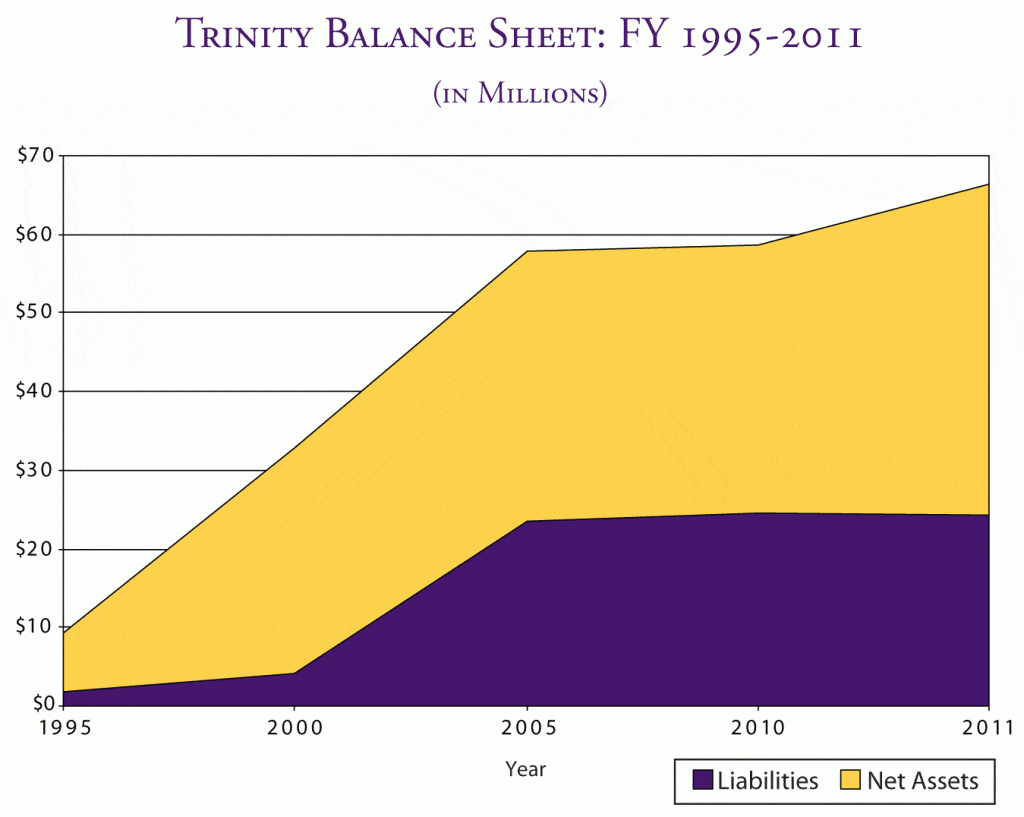
Trinity’s financial performance is benchmarked continuously against indicators derived from Moody’s ratings for similarly-sized private institutions. Trinity’s auditors at Brown Edwards provide benchmarks as well. For Fiscal 2011, some of the highlights of the benchmarks are included in the chart below.

Another indicator of the university’s fiscal strength is that Trinity is meeting all covenants associated with the bond issued for the Trinity Center.
Trinity is able to achieve these excellent financial results thanks to the strong enrollment performance and continuing firm financial discipline. Trinity’s budget is just about $35 million in Fiscal 2012, a relatively modest budget for the size of the enterprise.
Trinity’s revenue sources are uncomplicated. 80% of all revenues are derived from tuition. The chart below shows all revenue sources for the Fiscal 2011 budget.
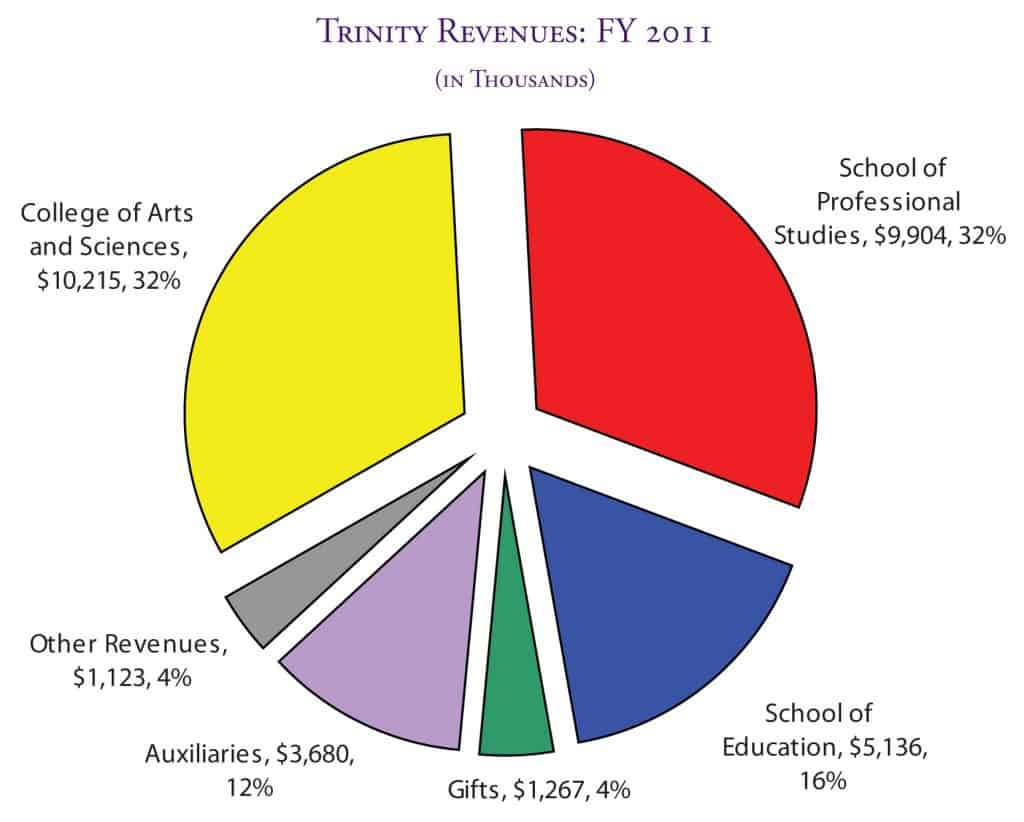
Trinity’s expenses are also relatively uncomplicated. Salaries and benefits account for roughly half of the budget, and the chart below shows all expenses for the Fiscal 2011 budget.
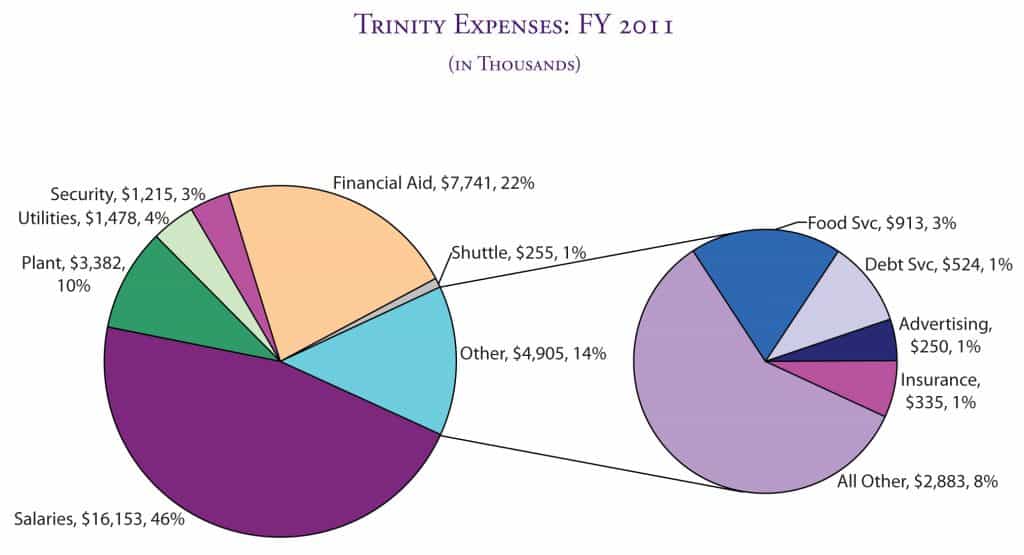
Even with so much success, accompanied by a large amount of fiscal discipline, Trinity continues to face very serious challenges for the future. The external economic environment is unstable, which is a concern for the long-term durability of the enrollment growth. Regulatory burdens are skyrocketing for all universities, and these burdens add cost while also restraining innovation.
Among all of Trinity’s challenges, however, the greatest is the need to renovate, modernize and enlarge our campus facilities in order to remain competitive and to meet the large demands of the modern academy with the kind of remarkably diverse student body that is now Trinity. This challenge is expensive, but necessary and urgent.
This website sets forth the case for the new Trinity Academic Center.
Trinity is deeply grateful to all benefactors who continue to support this great mission with generosity, love and loyalty. Your many charitable gifts truly contribute to changing lives every day.
